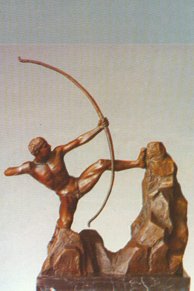Hayashiras, Hayaśiras, Haya-shiras: 8 definitions
Introduction:
Hayashiras means something in Hinduism, Sanskrit. If you want to know the exact meaning, history, etymology or English translation of this term then check out the descriptions on this page. Add your comment or reference to a book if you want to contribute to this summary article.
The Sanskrit term Hayaśiras can be transliterated into English as Hayasiras or Hayashiras, using the IAST transliteration scheme (?).
In Hinduism
Dhanurveda (science of warfare)
Source: Wisdom Library: DhanurvedaHayaśiras (हयशिरस्, “horse-headed”) refers to a kind of mythical weapon. It is a Sanskrit word defined in the Dhanurveda-saṃhitā, which contains a list of no less than 117 weapons. The Dhanurveda-saṃhitā is said to have been composed by the sage Vasiṣṭha, who in turn transmitted it trough a tradition of sages, which can eventually be traced to Śiva and Brahmā.

Dhanurveda (धनुर्वेद) refers to the “knowledge of warfare” and, as an upaveda, is associated with the Ṛgveda. It contains instructions on warfare, archery and ancient Indian martial arts, dating back to the 2nd-3rd millennium BCE.
Purana and Itihasa (epic history)
Source: archive.org: Puranic EncyclopediaHayaśiras (हयशिरस्).—Hayagrīva. (See Hayagrīva V).
Source: archive.org: Nilamata Purana: a cultural and literary studyHayaśiras (हयशिरस्).—According to the Mahābhārata, the fire of sage Aurva’s anger, cast into the sea, became the great Hayaśiras. The Viṣṇu Purāṇa and the Mārkaṇḍeya Purāṇa state that Viṣṇu appears as Hayaśiras in Bhadrāśva.

The Purana (पुराण, purāṇas) refers to Sanskrit literature preserving ancient India’s vast cultural history, including historical legends, religious ceremonies, various arts and sciences. The eighteen mahapuranas total over 400,000 shlokas (metrical couplets) and date to at least several centuries BCE.
Pancaratra (worship of Nārāyaṇa)
Source: eScholarship: Chapters 1-14 of the Hayasirsa PancaratraHayaśiras (हयशिरस्) is a name of Viṣṇu mentioned in the Śāstrāvatāra portion of the 9th century Hayaśīrṣa-pañcarātra.—“[...] for what reason did the mighty Viṣṇu previously become manifest as Hayaśīra [Hayaśiras] and what was the reason that the Lord of the Gods assumed a radiant body? [...] Mighty Lord Hayaśīrṣa—who was the slayer of Madhu and Kaiṭabha—when he was in the cosmic ocean—was asked by you Bhṛgu about the Pañcarātra. [...]”.
Hayaśira [Hayaśiras], Hayaśīrṣa and Hayagrīva are all names for the same horse-headed incarnation of Viṣṇu; haya means horse and śira, śīrṣa, head and grīva, neck, respectively.

Pancaratra (पाञ्चरात्र, pāñcarātra) represents a tradition of Hinduism where Narayana is revered and worshipped. Closeley related to Vaishnavism, the Pancaratra literature includes various Agamas and tantras incorporating many Vaishnava philosophies.
General definition (in Hinduism)
Source: Google Books: A Concise Encyclopedia of Hinduism1) Hayaśiras (हयशिरस्), also Hayaśirsa, Hayagrīva (‘horse-head’, ‘horse neck’).—The eighteenth avatāra of Viṣṇu, revealer of sacred lore.
2) Hayaśiras (हयशिरस्).—A demon who stole the Veda and was slain by Viṣṇu in the form of the Matsya-avatāra.
Languages of India and abroad
Sanskrit dictionary
Source: Cologne Digital Sanskrit Dictionaries: Cappeller Sanskrit-English DictionaryHayaśiras (हयशिरस्).—1. [neuter] a horse’s head; [Name] of a cert. myth. weapon.
--- OR ---
Hayaśiras (हयशिरस्).—2. [adjective] having a horse’s head; [masculine] a form of Viṣṇu.
Source: Cologne Digital Sanskrit Dictionaries: Monier-Williams Sanskrit-English Dictionary1) Hayaśiras (हयशिरस्):—[=haya-śiras] [from haya] n. a h°’s head, [Mahābhārata; Rāmāyaṇa] etc.
2) [v.s. ...] mfn. having a h°’s head (as the sun), [Mahābhārata]
3) [v.s. ...] m. Name of Viṣṇu (in the form of Haya-grīva), [Harivaṃśa; Bhāgavata-purāṇa]
4) [v.s. ...] f. Name of a daughter of Puloman, [Harivaṃśa]
5) [v.s. ...] of a daughter of Vaiśvānara (also -śirā), [Purāṇa]
6) [v.s. ...] n. a [particular] mythical weapon, [Rāmāyaṇa; Harivaṃśa]
[Sanskrit to German]
Sanskrit, also spelled संस्कृतम् (saṃskṛtam), is an ancient language of India commonly seen as the grandmother of the Indo-European language family (even English!). Closely allied with Prakrit and Pali, Sanskrit is more exhaustive in both grammar and terms and has the most extensive collection of literature in the world, greatly surpassing its sister-languages Greek and Latin.
See also (Relevant definitions)
Partial matches: Shiras, Haya.
Ends with: Ubhayashiras.
Full-text: Hayashira, Hayagriva, Vajishiras, Hayasya, Prithushiras, Hayashirshasamhita, Hayashirsha, Astra, Bhadrashva, Kratu.
Relevant text
Search found 10 books and stories containing Hayashiras, Hayaśiras, Haya-shiras, Haya-siras, Hayasiras, Haya-śiras, Hayaśiraḥ, Haya-śiraḥ, Haya-shirah, Hayashirah, Hayasirah, Haya-sirah; (plurals include: Hayashirases, Hayaśirases, shirases, sirases, Hayasirases, śirases, Hayaśiraḥs, śiraḥs, shirahs, Hayashirahs, Hayasirahs, sirahs). You can also click to the full overview containing English textual excerpts. Below are direct links for the most relevant articles:
Lord Hayagriva in Sanskrit Literature (by Anindita Adhikari)
Chronological Development (3): Udyoga Parva < [Chapter 3]
Hayagrīva in the Mahābhārata (Introduction) < [Chapter 3]
Central Myth (6): Birth of Madhu-Kaiṭabha < [Chapter 3]
Ramayana (by Manmatha Nath Dutt)
Narayaniya (Narayaneeyam) (by Vishwa Adluri)
Chapter 15 - (Mahābhārata 12.335.1-89)
Chapter 5 - (Mahābhārata 12.325.1-4)
The Vishnu Purana (by Horace Hayman Wilson)
The Agni Purana (by N. Gangadharan)
Chapter 348 - List of mono-syllabic words (ekākṣara)
Chapter 49 - Characteristics of forms of ‘Fish’ etc. of Viṣṇu
The Brahma Purana (by G. P. Bhatt)